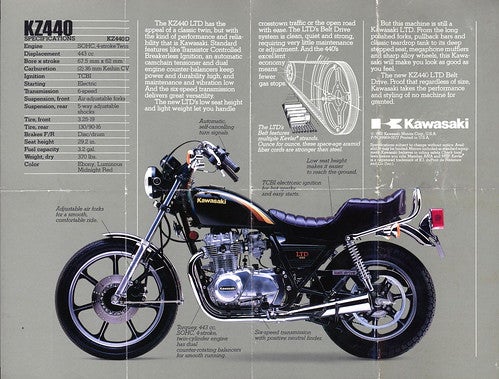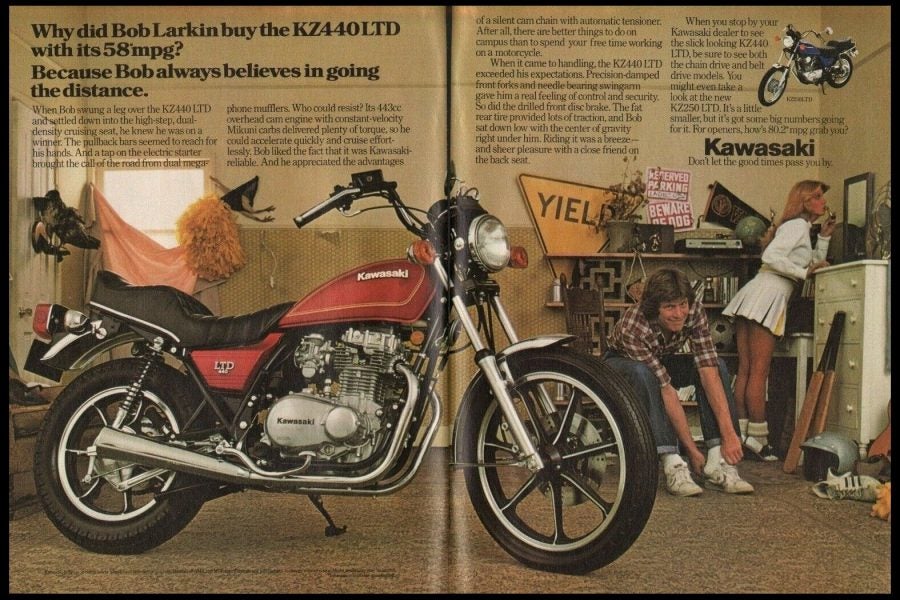As Kawasaki itself revisits the mini-cruiser territory it once dominated with the new Eliminator 450, and Harley-Davidson reveals its own built-in-India X440, it might be worth taking a look at the first time we saw this sort of bike in North America. I wouldn’t say the KZ440 LTD was the first small-bore cruiser in our market, but it was one of the earlier examples, and certainly one of the most successful. And, compared to the machines on the market today, it’s interesting to see what’s changed, and what hasn’t.
Designed in Japan, built in Nebraska
I think some markets got the KZ440 before others did, but around 1980, most of the world got the new Kawasaki 440 engine as an evolution of the previous 400 powerplant. The 440 ditched the 400’s kickstarter, and had a more robust top end. The air-cooled parallel twin (SOHC, two-valve head, six-speed gearbox) made a claimed 41 hp at 7,000 rpm, and 26 lb-ft of torque at 7,000 rpm. Kawasaki dropped this engine into standards, cafe-style bikes, and the LTD low-rider.
All the Japanese OEMs were building low-riders in the early 1980s, trying to steal sales away from Harley-Davidson and each other. While they’re often viewed as stylistic abominations today, these mini-cruisers were popular in their time. When you see an old KZ440 for sale in North America, it is almost certainly going to be an LTD variant, in my experience.
There may be a good reason for that—you can bet Kawasaki’s US factory focused on this particular model. Kawasaki built these bikes in Nebraska (along with many other machines). That’s where the Japanese cruiser scene got its start, with big-bore 900s and 1000s turned into low-rider muscle bikes. Eventually, the style spread across the line. Kawasaki and the rest of the Big Four were listening carefully to US dealers, and this was the style they wanted. Cornering capability went out the window, in favor of a low seat height, lots of chrome trim, and maybe a centerstand.
To be fair, they were building them in Nebraska, hundreds of miles away from the nearest switchback…
The LTD also came with a low-maintenance belt drive (translate that to “no-maintenance,” for most riders). At least there was a disc brake up front, which wasn’t true of all budget bikes at that time. In rear, there was a drum brake. Eighteen-inch wheels were standard front and rear. There was a weedy, wiggly, air-adjustable telescopic fork (on some models—others were non-adjustable) and wimpy preload-adjustable dual shocks in back. Dry weight was a claimed 370 pounds.
In many ways, the LTD took many of the failings of larger cruisers of the era and shrunk them down to match its smaller engine.

On the road, on an 1981 Kawasaki KZ440 LTD. This was one of the first big bike trips I ever did, and that gym bag on back is filled with as many tools as there are clean clothes. I took this thing all over Atlantic Canada, including many gravel and dirt roads. It never let me down; Kawasaki’s engineering and build quality were excellent. Photo: Zac Kurylyk
A reliable get-around machine
The 440 LTD wasn’t exactly a winner at local bench racing competitions—but so what? It was made as cheap transportation, and it excelled in that role. Production stopped around 1984, but many of these bikes were in use as daily drivers 20 years after they were made. I would know; I owned one. When I got it, it had served a couple of decades as an all-weather commuter in eastern Canada, and it was in rough shape. But except for some fouled spark plugs, I never had a mechanical problem with it, and used it to tour all over the Maritimes. The 3.6-gallon tank made it possible to get reasonable distances between fill-ups, and I bolted an old aftermarket rack to the rear for a gym bag full of clothes… and tools. Just in case. But I never needed them.

Kawasaki’s spec sheet for the KZ440 LTD. Although modern mini-cruisers would be far better bikes in the real world, it’s surprising how close some of the specs are on paper. They’re within 20 lb of the same weight, and Kawi’s new 450 puts out about 4 hp more than the old KZ440’s claimed 41 hp. Not that I think the KZ440 actually made 41 hp…
Compared to today’s equivalents
It would be silly to suggest the old 440 LTD is as good as modern machines like Kawasaki’s new Eliminator, or Harley-Davidson’s new X440. However, I’d suggest the 440 did a couple of things well, that modern manufacturers have neglected.
First off, it was a bike that was easy to maintain. Kawasaki’s new 450 liquid-cooled parallel twin engine is probably superior here, as the shim-and-bucket valve adjustment system is almost certainly going to require less fettling than the old 440 screw-adjust valves. But the new 450 comes with a chain drive, and I believe a belt drive would have been a far better choice, with almost no maintenance required. It may seem a small detail, but it makes a big difference to noob owners. Kawasaki has a history of putting belt drives on small-bore cruisers (454 LTD, Vulcan 500). Why take a step backwards?
As for Harley-Davidson’s new X440: We know almost nothing about the engine, but I’m surprised to see the air/oil-cooled single is rated for roughly the same torque as Kawi’s old LTD (28 lb-ft, at a much lower 4,000 rpm)… but far less horsepower. The X440, according to H-D’s India website, makes only 27 hp at 6,000 rpm.
You’d think, with 40 years of development since the old made-in-Nebraska Kawi twins, that we’d have come a bit further than that. And I’m sure, generally speaking, the new X440 is a far, far better bike, with fuel injection and proper brakes and ABS and superior chassis. But I can’t help but see some irony in the fact that a 40-year-old Japanese bike, made in America to steal sales from Harley-Davidson, is making more muscle than a modern H-D made in Asia to steal sales from Asian companies.
What a weird world we live in.
Buying a KZ440 LTD today
Most of these machines were rode hard and put away wet, but you do see them up for sale in good nick sometimes. In early 2022, a well-preserved example sold for $3,900 on Bring a Trailer. But these days, if you see one for sale, it’s more likely to be a custom job. Once all the cheap Yamaha XS650s were bought up and hacked apart, the KZ440 platform was one of the next most popular victims. For instance, see this cafe racer at Phillips Pro Cycle in Illinois. It’s optimistically listed at $3,695, which might have been doable a couple of years ago. Probably not in mid-2023, when pawn shops are doing booming business and consumer dollars are stretched.
If you do buy one: Try to find one with the original carb/airbox assembly intact. The stock Keihins only really run well with the stock airbox. If you’ve seen any attempt to monkey with either assembly, view it suspiciously. But as for me, I’d rather look for a larger four-cylinder LTD model in 2023. They’re roughly the same price; they might not be any better at cornering, but they’re a lot faster in a straight line. As always, YMMV!







